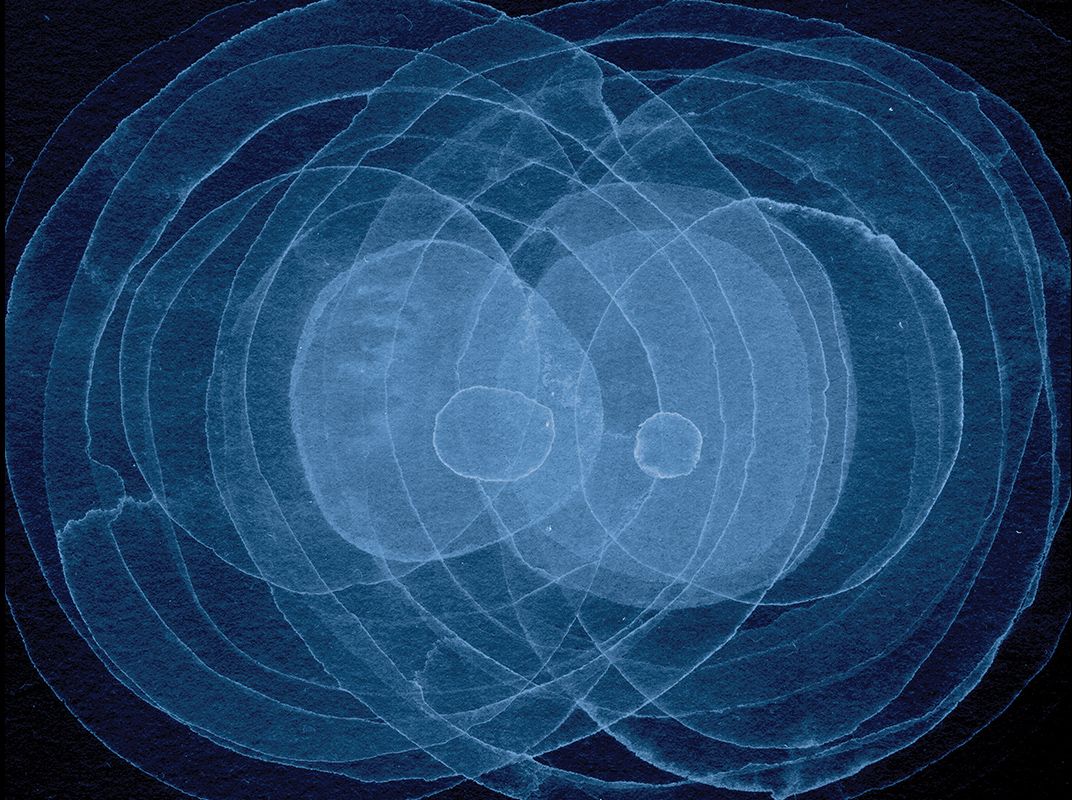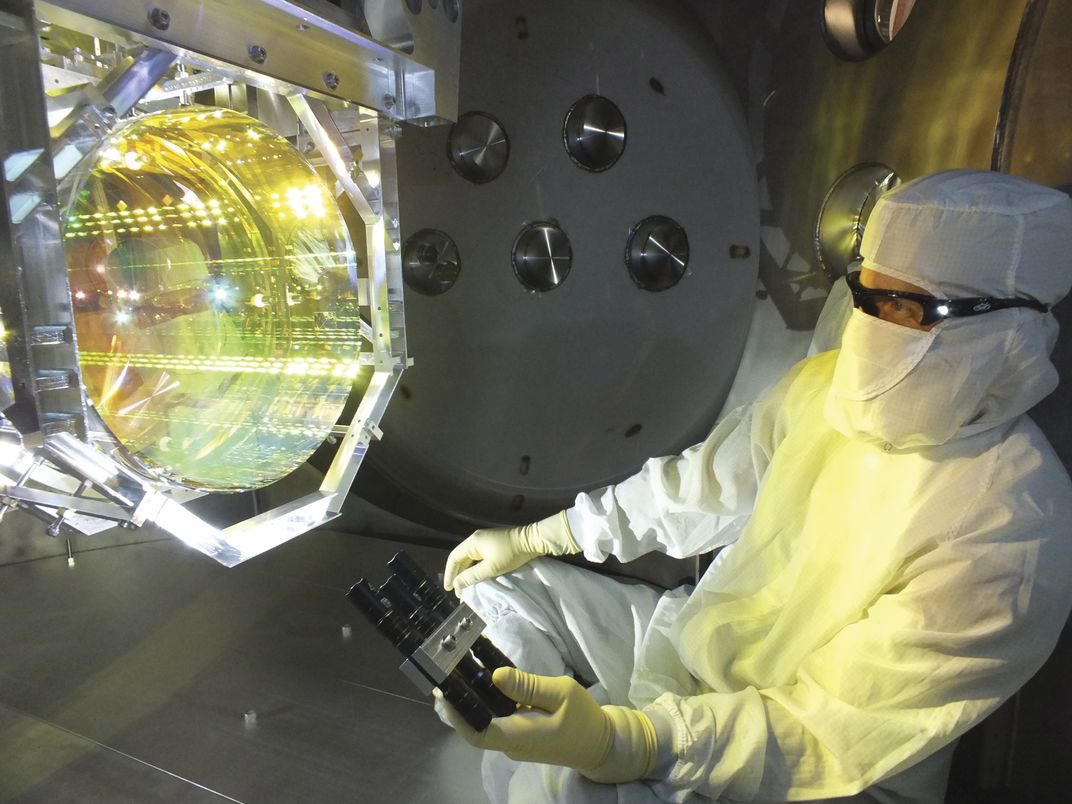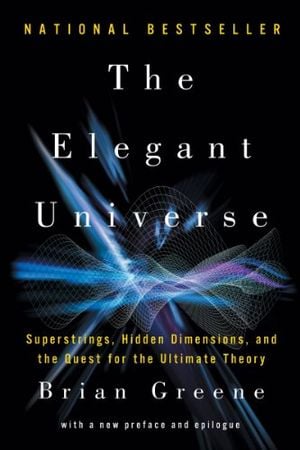The Detection of Gravitational Waves Was a Scientific Breakthrough, but What’s Next?
Scientists are sitting on top of the world after this monumental discovery and are eager to keep exploring the universe
/https://tf-cmsv2-smithsonianmag-media.s3.amazonaws.com/filer/df/d4/dfd4d502-9f95-4c69-83dd-840a400a3c8c/apr2016_k03_colgreeneblackhole.jpg)
More than a billion years ago, in a galaxy far, far away, two black holes executed the final steps in a fast-footed pas de deux, concluding with a final embrace so violent it released more energy than the combined output of every star in every galaxy in the observable universe. Yet, unlike starlight, the energy was dark, being carried by the invisible force of gravity. On September 14, 2015, at 5:51 a.m. Eastern Daylight Time, a fragment of that energy, in the form of a “gravitational wave,” reached Earth, reduced by its vast transit across space and time to a mere whisper of its thunderous beginning.
As far as we know, Earth has been bathed in this type of gravitational disturbance before. Frequently. The difference this time is that two stupendously precise detectors, one in Livingston, Louisiana, and the other in Hanford, Washington, were standing at the ready. When the gravitational wave rolled by, it tickled the detectors, providing the unmistakable signature of colliding black holes on the other side of the universe and marking the beginning of a new chapter in humankind’s exploration of the cosmos.
When rumors of the discovery started circulating in January, I rolled my eyes at what was clearly a false alarm or a ploy to stir up a little buzz. As a research program well into its fifth decade, the hunt for gravitational waves had long since become the major discovery that was always hovering on the horizon. Physicists had become resigned to waiting for their gravitational Godot.
But human ingenuity and perseverance have triumphed. It’s one of those victories that give even those of us cheering from the sidelines spine-tingling shivers.
Here’s the story, in a nutshell.
This past November, the world celebrated the centenary of Einstein’s greatest discovery, the general theory of relativity, which revealed a new paradigm for understanding gravity. Isaac Newton’s approach correctly predicts the gravitational attraction between any two objects but gives no insight into how something here can reach out across empty space and pull on something there. Einstein spent a decade trying to determine how gravity is communicated, and finally concluded that space and time form the invisible hand that does gravity’s bidding.
The metaphor of choice, overused but evocative, is to think of space as a trampoline. Place a bowling ball in the middle of the trampoline causing it to curve, and a marble will be nudged to travel along a curved trajectory. Similarly, Einstein professed that near an astronomical body like the Sun, the spacetime environment curves, which explains why Earth, much like the marble, follows a curved trajectory. By 1919, astronomical observations confirmed this remarkable vision, and made Einstein Einstein.
Einstein pushed his momentous discovery further. To that point, he had focused on static situations: determining the fixed shape of a region of spacetime arising from a given amount of matter. But Einstein then turned to dynamic situations: What would happen to the spacetime fabric if matter were to move and shake? He realized that much as kids jumping on a trampoline generate waves in the surface that ripple outward, matter that moves this way and that will generate waves in the fabric of spacetime that ripple outward, too. And since, according to general relativity, curved spacetime is gravity, a wave of curved spacetime is a wave of gravity.
Gravitational waves represent general relativity’s most significant departure from Newtonian gravity. Flexible spacetime is surely a profound recasting of gravity, yet in familiar contexts like the gravitational pull of the Sun or Earth, Einstein’s predictions barely differ from those of Newton. However, because Newtonian gravity is silent regarding how gravity is transmitted, the notion of traveling gravitational disturbances has no place in Newton’s theory.
Einstein himself had misgivings about his predication of gravitational waves. When first encountering the subtle equations of general relativity, it’s challenging to disentangle abstract math from measurable physics. Einstein was the first to engage in this tussle, and there were features that even he, the cynosure of relativity, failed to fully understand. But by the 1960s, scientists using more refined mathematical methods established beyond any doubt that gravitational waves were a distinguishing feature of the general theory of relativity.

How, then, could this iconic prediction be tested? In 1974, using the Arecibo Radio Telescope, Joseph Taylor and Russell Hulse discovered a binary pulsar: two orbiting neutron stars whose orbital period could be tracked with great precision. According to general relativity, the orbiting stars generate a steady march of gravitational waves that drain energy, causing the stars to fall closer together and orbit more quickly. Observations confirmed this prediction to a T, providing evidence, albeit indirect, that gravitational waves are real. Hulse and Taylor received the 1993 Nobel Prize.
The achievement only made the direct detection of gravitational waves all the more alluring. But the task was daunting. Calculations show that as a gravitational wave ripples through space, anything in its path will be alternatively stretched and squeezed along the axes perpendicular to the wave’s direction of motion. A gravitational wave headed straight toward the United States would alternately stretch and squeeze the space between New York and California, and that between Texas and North Dakota. By precisely monitoring such distances, we should thus be able to pinpoint the wave’s passing.
The challenge is that much as a ripple in a pond dies down as it spreads out, a gravitational ripple dilutes as it travels from its source. Since major cosmic collisions typically happen very far from us (thankfully), by the time the gravitational waves spawned reach Earth, the amount of stretching and squeezing they cause is tiny—less than an atomic diameter. Detecting such changes is on par with measuring the distance from Earth to the nearest star beyond the solar system with an accuracy better than the thickness of a sheet of paper.
The first attempt, pioneered by the University of Maryland’s Joseph Weber in the 1960s, used multi-ton solid aluminum cylinders, in the hope that they would gently resonate like giant tuning forks in response to a passing gravitational wave. By the early 1970s, Weber claimed success, big time. He reported that gravitational waves were ringing his detector almost on a daily basis. This momentous achievement inspired others to corroborate Weber’s claims, but after years of trying, no one could catch even a single wave.
Weber’s tenacious belief in his results, long after the amassed evidence suggested otherwise, contributed to a perspective that has colored the field for decades. Over the years, many scientists believed, as did Einstein, that even if gravitational waves were real, they would simply be too weak to ever be detected. Those who set out to find them were on a fool’s errand, and those who believed claims of detection were being fooled.
By the 1970s, the few who still had the gravitational wave bug turned to a more promising detection scheme in which lasers would be used to compare the lengths of two long identical tunnels oriented at 90 degrees to each other. A passing gravitational wave would stretch one tunnel while squeezing the other, slightly changing the distances traveled by laser beams fired along each. When the two laser beams are subsequently recombined, the resulting pattern that the light forms is sensitive to minute differences in how far each beam has traveled. If a gravitational wave rolls by, even the minuscule disturbance it creates would leave a modified laser pattern in its wake.
It’s a beautiful idea. But nearby jackhammers, rumbling trucks, gusts of wind or falling trees could disturb such an experiment. When seeking length differences of less than a billionth of a billionth of a meter, the ability to shield the apparatus from every possible environmental agitation, however slight, becomes paramount. With that seemingly insurmountable requirement, the naysayers were provided yet more ammunition. Catching a gravitational wave would render Horton’s hearing a Who, even over the roaring din of the New York City subway, mere child’s play.
Nevertheless, the American physicists Kip Thorne and Rainer Weiss, later joined by the Scottish physicist Ronald Drever, dreamed of building a laser-based gravitational wave detector, and they set the wheels in motion to make that dream a reality.
In 2002, after a couple of decades of research and development and more than a $250 million investment from the National Science Foundation, two scientific and technological marvels that make up LIGO (Laser Interferometer Gravitational-Wave Observatory) were deployed in Livingston, Louisiana, and Hanford, Washington. Four-kilometer-long evacuated tunnels in the shape of a giant letter “L” would house a laser beam some 50,000 times more potent than a standard laser pointer. The laser light would bounce back and forth between the world’s smoothest mirrors, placed at opposite ends of each arm, seeking a tiny mismatch in the time it takes each to complete the journey.
The researchers waited. And waited. But after eight years, nothing. Disappointing, to be sure, but as the research teams argued, not surprising. Calculations had shown that LIGO was barely at the sensitivity threshold necessary to detect gravitational waves. So in 2010, LIGO was shut down for various upgrades, to the tune of more than $200 million, and in the fall of 2015, an improved LIGO, many times more sensitive, was turned on. Shockingly, less than two days later, a sudden shiver rattled the detector in Louisiana, and seven milliseconds later the detector in Washington twitched in almost exactly the same way. The pattern of the delicate vibrations matched what computer simulations predicted for gravitational waves that would be produced by the final throes of orbiting black holes that crash together.
A friend of mine on the inside, sworn to secrecy but willing to provide a not-so-subtle hint, told me, “Just imagine that our wildest dream has come true.” But it was this hitting of the gravitational-wave-jackpot that gave the researchers pause. It was almost too perfect.

With a few months of intense, diligent effort of carefully investigating all other explanations, however improbable, only one conclusion was left standing. The signal was real. A century after Einstein predicted their existence, the first direct detection of gravitational waves was celebrated by the more than 1,000 scientists working on the LIGO experiment. They had caught the momentary murmur of a gravitational tsunami unleashed more than a billion years ago, the vestige of a dark merger somewhere in the deep southern sky.
The official press announcement, on February 11, in Washington, D. C., was electric. At my own institution, Columbia University, we had to move the live-stream of the proceedings to one of the largest venues on campus, and similar stories played out in universities worldwide. For a brief moment, gravitational waves trumped presidential prognostication.
The excitement was warranted. History will look back on the discovery as one of those few inflection points that change the course of science. Ever since the first human looked skyward, we have explored the universe using waves of light. The telescope substantially enhanced this ability, and with it we encountered the splendor of new cosmic landscapes. During the 20th century, we broadened the kinds of light signals we detect—infrared, radio, ultraviolet, gamma and X-rays—all forms of light but with wavelengths outside the range we can see with the naked eye. And with these new probes, the cosmic landscape grew richer still.
Gravitational waves are a completely different kind of cosmic probe, with the potential of yielding even more dramatic consequences. Light can be blocked. An opaque material, like a window shade, can block visible light. A metal cage can block radio waves. By contrast, gravity passes through everything, virtually unchanged.
And so, with gravitational waves as our probe we will be able to examine realms that are off-limits to light, like the chaotic spacetime scramble as two black holes collide or perhaps the wild rumble of the big bang itself, 13.8 billion years ago. Already, the observation has confirmed the idea that black holes might form binary pairs. More tantalizing still, we may find a dark landscape populated by things we’ve yet to even imagine.
As a network of detectors across the globe—in Italy, Germany, soon Japan and likely India—pool their data, hopefully to be joined in the future by an enormous detector operating in space, our ability to probe the cosmos will take another giant leap forward. Which is utterly thrilling. There’s nothing more inspiring than our capacity, in the midst of our ever-present terrestrial struggles, to look up, to wonder, and to have the ingenuity and dedication to see a little farther.
**********
Watch author Brian Greene explain gravitational waves:
Related Reads

The Elegant Universe
/https://tf-cmsv2-smithsonianmag-media.s3.amazonaws.com/accounts/headshot/B_Greene_Color_21.png)



/https://tf-cmsv2-smithsonianmag-media.s3.amazonaws.com/accounts/headshot/B_Greene_Color_21.png)